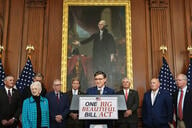You have /5 articles left.
Sign up for a free account or log in.
President Obama's plan for free community college. Bernie Sanders's vision of two years of debt-free college. Lamar Alexander's nascent proposal to rewrite the Higher Education Act to produce a more effective higher ed system. Elizabeth Warren's double-barreled push for more federal and state funding and greater accountability. Hillary Clinton's $350 million proposed overhaul of higher ed financing.
Those are just some of the many public policy proposals circulating right now to revamp how the various parties involved in financing higher education -- the federal and state governments, colleges and universities, philanthropic groups, and students and families -- interact to do that. All of them, in one way or another, start with the premise that higher education is increasingly unaffordable for too many Americans.
But what does "affordable" even mean? And if politicians, policy makers and the public don't have a shared understanding of what families should pay for college, can we really expect them to develop and agree on what to do about the problem?
Officials at Lumina Foundation don't think so, which is why they are today offering up a simple (and, they admit, somewhat simplistic) framework for concretely defining what is reasonable for the typical college student and her/his family to pay for college.
Most discussions about higher education affordability focus on what colleges charge students (too much is almost always the conclusion) and what they should charge (less). The Lumina document, crafted with input from a working group of experts, approaches the question from another angle: "We want people to be able to use this as a gauge for what people have the capacity to pay," said Zakiya Smith, Lumina's strategy director.
The paper is peppered with caveats and other language designed to make clear that this is not meant to apply to all students and situations, given differences in personal circumstances. But -- arguably in conflict with some of the politically attractive ideas circulating about "free" higher education -- it embraces the broad principle that families and students should be expected to contribute to paying for their own educations, through savings, a percentage of disposable income and student work. The paper essentially sets an envisioned maximum for their contributions.
The slightly gimmicky Lumina model -- which Smith acknowledges was designed to be something the "average person can understand" -- is based on what the foundation calls the rule of 10.
First, families should be expected to contribute to their children's education what is reasonable for them to save over 10 years. Second, that "reasonable" amount they save over that decade should be based on 10 percent of their disposable income, which Lumina notes has become the standard for affordable loan repayment. (The savings expectation would apply only to those families who earn more than 200 percent of the poverty level.) And third, the foundation asserts that students can reasonably work 10 hours a week during the academic year without impairing their academic success.
Those guidelines can be viewed in multiple ways. They might be seen, for instance, as embracing the idea that many if not most students should be expected to work as their part of paying for college. But Smith noted that while the foundation's working group agreed broadly that 10 hours is a reasonable level, its members also agreed that "working more than this is not desirable" -- and that many students currently work much more than this. "So you might see the document as suggesting a limit on student work." (Clinton's funding plan discusses the role of student work as an essential element of financing college.)
Reactions From the Field
Several experts on financial aid offered praise for Lumina's general approach, as well as some caveats about the proposal's details.
Donald E. Heller, dean of the college of education at Michigan State University and a leading researcher on financial aid and higher ed finance, compared much of the public policy discussion about college affordability to Justice Potter Stewart's definition of obscenity -- "I know [affordability] when I see it," and, more importantly, when it's not affordable.
"It's conceptually a good effort … to try to come up with a definitive, numbers-driven definition," Heller said. He also praised the foundation's "clear recognition that free college shouldn't be the goal we should be striving for," partly because it's impractical and because "there should be some cost to college, just as there has been for hundreds of years."
Heller and Sarah Flanagan, vice president for government relations and policy development at the National Association of Independent Colleges and Universities, both noted that the numbers Lumina chose for the various thresholds "might not be the exact right ones," as Flanagan put it (and as Lumina concedes).
But the document "gets you really thinking about what the role is of each of the partners in making college affordable," Flanagan said, "what is reasonable to ask of every player, starting from the bottom up with what should families be expected to do."
If general consensus could be reached on that, she said, that would help define the landscape for a discussion of the responsibilities and expectations of the other players -- colleges, states, the federal government -- in making college affordable.
"Maybe we have that same kind of model for states, for the government," she said. "It's an optimistic framework, and assumes all parties have good intentions. But if we sort of keep on blaming each other, saying, 'You should be doing more,' 'No, you should be doing more,' we're not going to make much progress."
Heller shares Flanagan's admiration for the Lumina concept, and says its timing is good, given all the political discussion about affordability and student debt.
But he admits to more skepticism about the affordability benchmark's usefulness, especially in the current climate.
"I have trouble thinking that the conversation is going to have much influence," he said. Even if states were to somehow embrace the idea that their residents could afford to contribute only so much to their educations, and commit to doing their part to pick up the rest of the tab, "look what happens with funding formulas …. In bad economic times, those go out the window."





